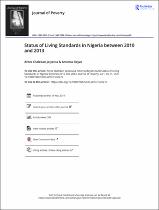| dc.contributor.author | Jaiyeola, Afeez Olalekan | |
| dc.contributor.author | Bayat, Amiena | |
| dc.date.accessioned | 2023-06-05T07:38:20Z | |
| dc.date.available | 2023-06-05T07:38:20Z | |
| dc.date.issued | 2020 | |
| dc.identifier.citation | Jaiyeola, A. O., & Bayat, A. (2020). Status of living standards in Nigeria between 2010 and 2013. Journal of Poverty, 24(1), 45–7. https://doi.org/10.1080/10875549.2019.1692270 | en_US |
| dc.identifier.issn | 1540-7608 | |
| dc.identifier.uri | https://doi.org/10.1080/10875549.2019.1692270 | |
| dc.identifier.uri | http://hdl.handle.net/10566/9002 | |
| dc.description.abstract | Nigeria experienced a drop in the poverty rate to an average of56.1% between 1999 and 2007. This could be attributed to themeasures taken by the civilian government against adminis-trative corruption, increased domestic and foreign investmentsand some implemented agricultural policies. These effortswere thwarted by subsequent administrations with devastatingeffects on the Nigerian population. Despite an average annualeconomic growth rate of 6% between 2004 and 2010, theincidence of poverty has remained high, increasing from54.7% in 2004 to 60.9% in 2010. The high rate of poverty inNigeria has reached alarming proportions. It is in recognition ofthis that this study analyzes the variations in poverty across thesix geopolitical zones of Nigeria, including the rural and urbanareas | en_US |
| dc.language.iso | en | en_US |
| dc.publisher | Taylor and Francis Group | en_US |
| dc.subject | Poverty | en_US |
| dc.subject | Economic development | en_US |
| dc.subject | Unemployment | en_US |
| dc.subject | Nigeria | en_US |
| dc.subject | corr | en_US |
| dc.title | Status of living standards in Nigeria between 2010 and 2013 | en_US |
| dc.type | Article | en_US |

